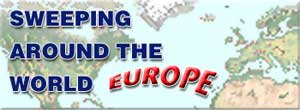
Copenhagen
by Ranger Kidwell-RossIn Copenhagen, I met with three members of the management team responsible for keeping the city clean, Jens B. Sørensen, Lars Lyng and Poul Wendel Jessen. After a brief discussion in the office, we sped off to Copenhagen's central square where three different types of sweepers were waiting for a photo opportunity.
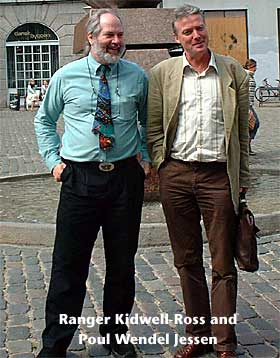 |
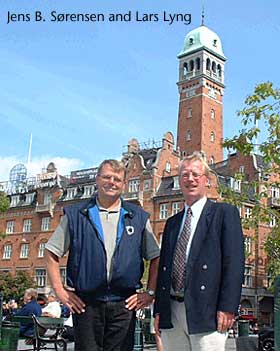 |
|
The city of Copenhagen employs nearly 200 workers to clean its 374 kilometers of public roadways (approximately 233 miles), and its 704 km of sidewalks and 291 km of sidewalks. An additonal 352 km of private roads are maintained by their owners or independent contractors. Hako and Schmidt manufacture most of the city's 25 sweepers, all of which are smaller than a typical American parking lot sweeper. The streets of Copenhagen are swept by a combination of city personnel and independent contractors. Bids usually run for a maximum of 5 years. Contractors bid on providing a general cleanliness level, rather than a certain amount of sweeping. If the cleanliness level is attained, the contractor is subject to fewer inspections by the city management. |
|
|
Copenhagen has more bicycles per capita than anyplace I've ever been, with the possible exception of Beijing. Bicycles are parked virtually everywhere, creating a huge difficulty in cleaning the pavement. And, as in the rest of the European countries I've visited so far, cars line the streets at all hours night and day. There is no time of day when the curb lines can be cleaned on an entire street, and certainly no place to relocate the cars if the streets were closed so sweeping could take place. |
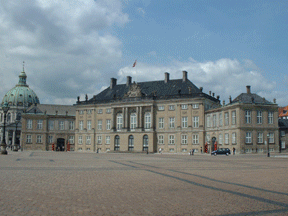
|
One of the ways the agency promotes an environmental future is by trying out new technologies and evaluating their potential for future use. An agency 'thumbs-up' allows a technology to become incorporated more quickly into the private sector. Some examples include the use of low-sulfur diesel and electricity-powered vehicles. |
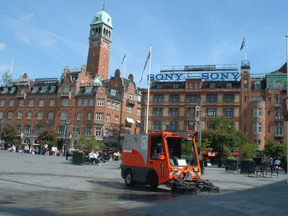
|
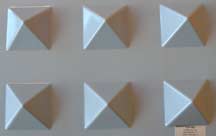
The agency is currently testing a mechanism that uses a high-pressure blast of small ice crystals for the removal of graffiti. This technique also works to remove gum on sidewalks and parking areas. If the results prove promising, this new technology will provide an environmental leap forward from the sandblasting, chemical use and/or pressure-washing that has gone before. This appears to be a much more environmentally-friendly method than any other I've ever heard of. The agency is also experimenting with coating the surfaces of electrical control panels, etc., with a plastic infused with pointed cones, so that posters can't be attached to the surface.
Instead of using disposable liner bags in the garbage cans throughout the city, Copenhagen government uses rigid plastic liners that can be dumped and reused over and over. "We don't like the idea of throwing away a plastic bag every time we dump a can," said foreman Jens B. Sørensen, "and it presents health and safety issues for our workers -- needles and other sharp items -- when we used the thin, throwaway liners.
"Our new system allows the same liner to be used over and over. We also put a sticker on each can, which asks citizens to call our hotline when the can is full. In the highly trafficked areas, we dump out the liners every other hour. At the same time, the area around the bins is swept up so it doesn't get the chance to become really messy. Real sweeping happens later in the day, when the sweeper fleet cleans the pavement."
The garbage is dumped into a small vehicle outfitted with a trash compactor, then the liners are put back into the can. If the liner becomes dirty, it's replaced with a clean one, and the dirty liner is taken to a washing facility.
Copenhagen employs another area of environmental activism with its approach to weed removal from cracks in the pavement. Averse to the use of chemicals to solve this problem, the city employs workers to burn the weeds with a propane torch. This kills the existing weeds, and reduces the number that re-grow in an area. Best of all, it introduces no toxic pesticides in the process.
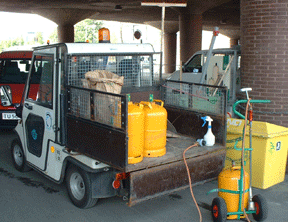
Copenhagen's streets and plazas are composed of a variety of materials, mostly paving stones of varying size. Many of these stones have been laid in intricate patterns, and are embedded in sand, as opposed to anchored in a hard surface. In many places, the sand bed is several inches below the surface of the cobblestones, leaving plenty of space for debris to become lodged. It's a relative cleaning nightmare.
Another problem is finding matching fill material when a particular type of paving stone fails. Currently, the city has contractors working on finding a match for one area where the foundation sand has sunk, allowing many of the paving stones to break. Unfortunately, no matching pavers can be located.
In terms of disposal, sifted sweeping debris is sometimes used as roadbed underlayment, a practice often used in the U.S. In Denmark, a rubber membrane is laid on top of the sweepings so if groundwater toxicity is discovered, workers can easily dig down and locate the sweeping material.
Denmark appears to treat its citizens well. The country's 50% income tax rate buys full medical benefits for the citizens and, if unemployed, they receive full wages for 3 to 6 months. After that, unemployment insurance kicks in at the rate of about $2,000 per month for the next five years. There is also an official Lutheran Church of Denmark, which is, in part, supported by taxes.
Noise is always a factor that's taken under consideration when developing a city's sweeping program. Copenhagen sweepers begin operating early in the morning, about 4 or 5 am. Sweeping continues in an area until traffic becomes too heavy, then the sweepers are moved to another, less congested, area. The public information program for sweeping seems more developed in Copenhagen than in most places, however, and the citizens reportedly have few complaints about what's entailed in keeping their city clean.
"People realize we are helping them maintain a nice clean city," said Lars Lyng. "We put a lot of effort into communicating with the citizens about what we're doing and why we're doing it. Whenever we try new things, we inform the press to let everyone know about it. This greater public awareness pays us many dividends.
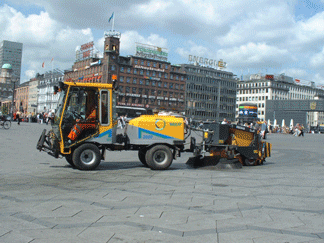
"We also try to develop amicable relationships with the contractors who do work for us. But, we do check up on them. If they haven't done a good job, they'll go and fix it. These relationships are very good, though; we don't believe in having 'wars' with anyone who provide services to us. We all agree on the level of quality that is to be delivered, and the contractor is willing to maintain that level for us."
That 'partnership' relationship is also strived for with the residents of Copenhagen. The cleaning agency has a yearly promotion designed to remind everyone of why the sweeping is done, and to request help in keeping the city clean by using the garbage cans and picking up after themselves. This approach appears to be working well.
"This upcoming year, we're looking to add a new element to our clean city campaign. We hope to develop a comparison of what it costs to sweep the streets in order to remove the majority of debris, rather than just emptying the garbage cans. Our goal is to be able to tell the citizenry that if they increase their use of garbage cans by a certain amount, we might be able to build a new playground with the money that's saved. It's a very political issue, and we believe education is a very important part of helping to keep our city clean."
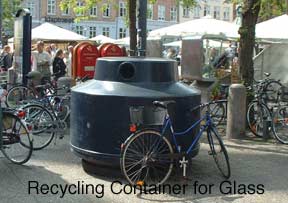
In Copenhagen, many glass bottles carry a deposit tax that's the equivalent of 30 cents in the U.S. As a result, very few bottles can be found lying around the streets, etc. For convenience, the city provides containers for glass recycling, and the deposit money helps cover the cost of emptying the containers and transferring the glass to recyclers. Unfortunately, it does little to alleviate the very noticeable broken glass problem in the tourist areas of town. Accidental breakage leaves glass into the cracks of cobblestones that must be removed by vacuum machines or by hand-sweeping. If there was a way for Copenhagen to address this problem -- by outlawing use of glass containers out in the streets, for example -- it would be a huge help toward mitigating this challenging aspect to the city's cleaning capability.
Another aspect of Copenhagen's cleaning duties involves taking care of the city's 22 public fountains. This means cleaning the areas around the perimeter of the fountains where people sit and eat, as well as taking out any material that has been put into the fountain. The contractors in the sections of town that have fountains are responsible for cleaning them.
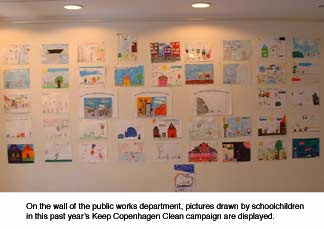
"We haven't privatized all the services in Denmark," explained manager Poul Wendel Jessen. "However, we do use many private companies. The citizens expect a high level of services because of our relatively high tax rate. In Copenhagen, we have a public works department that delivers the services; however, we are split apart so we can provide better services. We tell our contractors what work we need done in particular section, negotiate the pay, then look after them to make sure they deliver what we're paying them for. Our goal is to deliver the best services, at the lowest price, to the citizens of Copenhagen.
"When we see a problem, we don't try to cover it up. We'll investigate until we find solutions that will keep it from happening again. Denmark is one of the front-runners in developing European environmental strategy, and we do what we anticipate will be done in the rest of Europe, as well.
"For example, Denmark first introduced lead-free gasoline 25 years ago. Now, finally, everyone is using it. We try to take that leadership stance in everything we do as a government and as a country. If we find a problem that involves pollution in sweepings, for example, we don't just want to clean it up. We want to find out where it came from and eliminate the source," Jessen explained.
"Whenever a car tire is purchased in Denmark, about one U.S. dollar goes for the recycling of it later when it's worn out," remarked Lars Lyng, recounting from his former experience in the recycling industry. "This money is used for cutting the tires into pieces and finding ways to reuse them. Tire recyclers, the people who cut them up and develop the reuse locations, can make between $200-250 U.S. per ton. So, you won't see any used tires lying around in Denmark. We work with recycling agencies for all materials, to come up with the best possible systems in every area. The highest level for approaching environmental situations is, to us, being proactive enough that we discover a problem and fix it before it's noticed by our citizens."
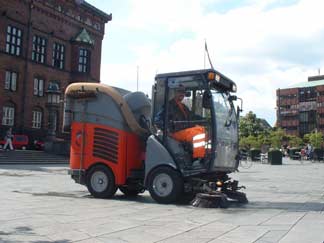
The roadways in downtown Copenhagen are high tourist areas near the city's waterways. The streets are outfitted with curbs that prevent storm run off from entering the water. All the runoff is directed into storm sewers, where it's cleaned prior to being discharged into the sea. The warehousing district, which for years was a high level polluter, has also been relocated from its previous location next to the waterways. These factors have significantly reduced the pollution levels, and allow the citizens of Copenhagen to truly enjoy their beautiful surroundings.
Waterways throughout the city have recently become much cleaner than in prior decades. As a result, two new swimming areas have been introduced in the past year. For the first time since the 1950s, the harbor water is clean enough to allow that activity to resume. And, fishing is once again allowed again in the city harbor, as well. This is a definite benchmark for the improvement that has taken place in recent years.
"We have been able to show the citizens of Copenhagen the ongoing benefits from the taxes they pay us. Being able to swim and fish in the harbor again is very exciting for all of us. We no longer have the heavy metals in our waterways. The shoreline is now available to our citizens to use. That's the type of improvement we want to show, consistently, and it's a direct result of the cooperation we've developed between the citizens, authorities and industries. Due to this success, people no longer want to leave Copenhagen to live elsewhere. Now, it's very popular to live here, even for families with children, and our high level of environmental cleanliness is a big reason for that."
Unlike in the U.S., where a city is required to file a storm water runoff plan if its population reaches 25,000, in Denmark, cities of any size must file a report with the country's EPA, outlining their plan and the best practices they are using.
As mentioned earlier, Copenhagen is an extremely difficult city to sweep, primarily because of the widespread use of bicycles. There is a separate bike lane throughout the city, which is raised slightly above the car lane. This creates an uneven pavement situation that must be a nightmare for any air sweeper. Combined with the difficulty of removing material from in between the cobblestones, the resulting challenge of efficient sweeping is staggering.
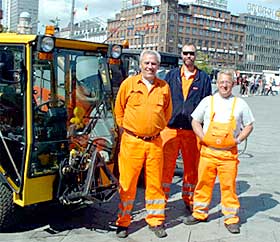
On balance, the City of Copenhagen is doing an excellent job of cleaning its paved surfaces. This is reflected in many ways, from the appearance of the streets to the quantifiable increases in water quality the city has seen in recent years. Management is taking a balanced approach toward getting the job done, from investigating emergent new methods for improving efficiency to taking steps to ensure its citizenry is a partner in supporting and sustaining an ongoing level of improvement.
Given the five cruise ships and the many tour buses I saw on the day I conducted this interview, the city managers -- and the contractors they work with -- are to be commended for doing a fine job in far less than ideal circumstances. Denmark is known throughout the world for taking the lead in many social and environmental areas, and it appears that sweeping, in Copenhagen anyway, ranks among those at the top.
 |
 |
Back to Table of Contents for Sweeping in Europe
© 2005 - 2021 World Sweeper |